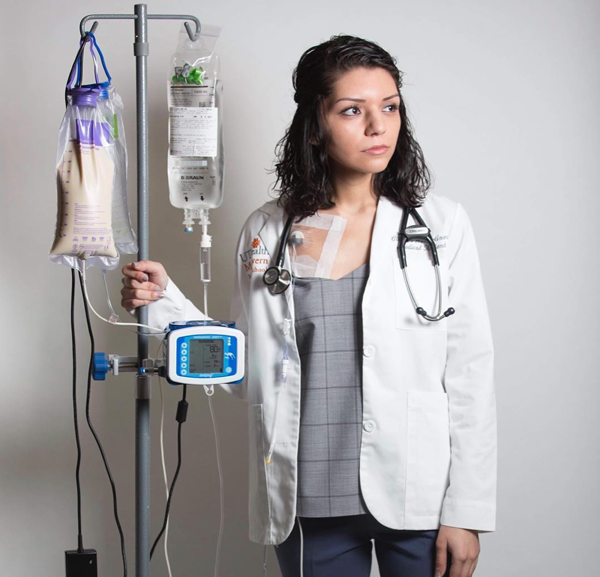Walking up to the admissions desk I knew the routine. I stretched out my arm for my hospital band. A name, a number, and a doctor were what defined me during my many hospital stays. It was simple; my brain was too large for my skull. Brain surgery after brain surgery has occupied my life for many years, all while I have been studying to become a doctor.
I just began my 3rd year at McGovern Medical School in the Texas Medical Center. I have always wanted to become a doctor. But, I never thought I would be working towards that dream while being a patient myself. I’ve had 6 brain surgeries, multiple shunt surgeries, multiple feeding tube and port surgeries, and multiple hospitalizations. In February 2017, during my last brain surgery, I suffered a stroke to my brainstem. Initially, I was unable to function from the neck down. I had to relearn how to feed, bathe, dress myself and how to walk again. Everything we do and take for granted in everyday life, I had to relearn.
I always hoped for the day I’d be cured when I’d no longer be the patient, only the doctor. Because for so long, I was made to believe the two could not exist simultaneously. You are the patient or you are the doctor. Never both.
As I sit here in the hospital with my white coat on and a stethoscope around my neck waiting to see patients, I, too, look as if I am a patient. Glued to my back is a heavy backpack containing liters of IV fluids, nutritional feedings, a feeding tube pump, heparin and saline flushes, syringes, dressings, caps and sterile swabs. A tube from my port that goes into my heart and a GJ feeding tube that goes into my small intestine tethers me to this backpack. My gait is abnormal and my hand function is quite limited. But, as I sit here and marvel at my situation, in a way, I hope I am never cured. Perhaps I am not meant to be a “normal” doctor, but a voice to bridge the gap of those who are solely doctors and those who are solely patients.
Over the years, many doctors, professors, and advisors told me to quit medical school. They said, “Your medical history is too extensive. You don’t have the functioning you need. It would be impossible for you to continue school while being a patient in the hospital so much”. The more they told me, the more I started to believe they were right.
Furthermore, I remember one neurologist walked into my hospital room and asked everyone to leave. She sat down at the foot of my bed and looked me straight in the eye and said, “Claudia, you have to give it up. You can’t be a doctor”. After telling her that I disagreed with her opinion, she went on to tell me, “Look at where they are and look at where you are”. (“They” referring to my classmates who were rounding with her on my case). “Lift up your legs!”, she yelled, “Lift up your legs!”. (At the time I couldn’t move my legs ). “See, you can’t even lift up your own legs. You can’t even take care of yourself! How can you take care of a patient?”, she told me.
I will never forget that day. All these years, I wish I would have known someone fighting a serious illness while also trying to get through medical school. I wish I had someone to look up to, someone to show me that it is possible. I have shared my story in hopes to find others like me. And I have found that just because we are underrepresented doesn’t mean we are not out there. I am here to represent and bring light to those in the medical profession who have a disability, who battle health issues, those who have been underrepresented in the media for far too long.
Unity to me is including everyone with a disability. You may see a girl who has overcome adversity with resilience. But, I hope you also see a girl who is only human, a girl who has a disability, a girl who is good enough to still become a doctor.
In my medical school and across the country, I’m working to bridge the gap of physicians and medical students who are also patients themselves. As healthcare providers, we are not immune to illness and instead we should embrace these individuals who are on both sides of the bed. They provide a link to those who are solely doctors and those who are solely patients. Unity to me is inclusion.
To those like me who find themselves on both sides of medicine, they say there is a light at the “end” of the tunnel.
But I’ve learned sometimes there may never be a true “end” to a medical condition. That light may stay beyond our reach. Perhaps, this is when we should create light for ourselves. We should encourage others to see us just as we are, to show how we can shine despite the darkness.
To see more of Claudia’s story, you can follow her online @claudiaimartinez on Instagram.



